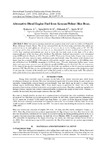| dc.description.abstract | Rice bran used as biomass material was acquired from small scale rice millers in Wang’uruMwea,
Kirinyaga County, Kenya. The oil was extracted from the rice bran using petroleum ether which was
preferred due to its high affinity for oil and ease of recovery due to its low boiling point of 40o
-60o
. The
percentage of free fatty acids in the rice bran oil was determined by titration method and was found to be
3.22%. Acid catalyzed pretreatment was used to lower the free fatty acids to less than 2.5% to allow
transesterification of the rice bran oil to biodiesel. The following biodiesel characteristics were determined
using ASTM methods; Density at 20oC, Viscosity at 40oC, Flash point, Cetane index, Copper strip corrosion,
Ash content, pH value, refractive index, distillation point and Calorific value. The density of the biodiesel was
higher than the acceptable ASTM 1298 range by 1.4% and the calorific value of diesel was 45.52MJ/Kg while
that of biodiesel was 38.92MJ/Kg amounting to 14.5% decrease. Viscosity, flash point, boiling range, cetane
index, and copper strip corrosion were all within the specified ASTM range for diesel fuel. The ash content was
0.5% compared the specified maximum of 0.01% for diesel this was attributed to the oil extraction method and
the level of FF. The pH value was low and though this could not affect the performance of the biodiesel as a fuel
it can cause the corrosion of the metallic parts of the fuel systems as well as the engine walls. The refractive
index of the biodiesel was approximately the same as that of diesel. | en_US |

